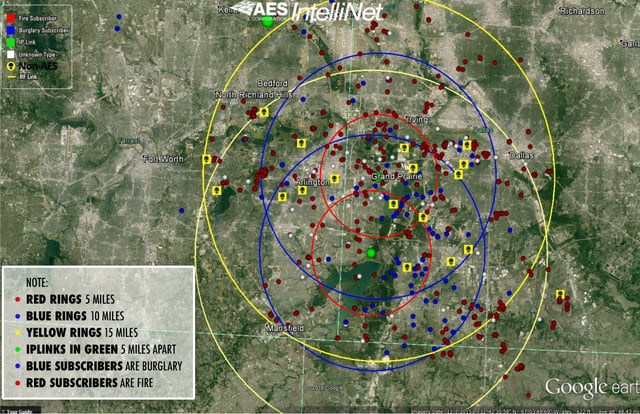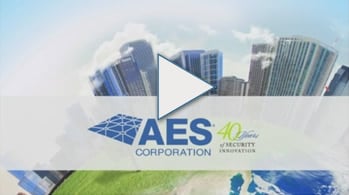Location, Location, Location
The following guidelines are critical to the success of your AES-IntelliNet private wireless mesh radio network. Just like with real estate, “location, location, location” is key. IP Links are often installed in the alarm dealer’s or central monitoring station’s office for easy serviceability or due to the concern of losing a site after the network is built. The beauty of the IP Link is that it can be installed anywhere and that it should, if possible, be the center of your radio cloud or as close to the center as possible. Please see the example as illustrated in the diagram below. Note, the rings represent a 3 to 5 mile radius in distance. That distance between the AES subscribers is defined as level, link layer, or hops.
Deploying an AES-IntelliNet Network
A common response to viewing this diagram is, “I cannot sell customers in rings.” The thinking behind that statement is that every install must be a brand new sale. Think beyond new sales and use your existing customer base, too. Remove a cellular system in that ring and repurpose it further out.
The Key to Network Stability
Since the performance of IP Links is the key to having a healthy and successful mesh radio network, the following guidelines are recommended for installation:
- When building a new network, a minimum of two IP Links and the distance between them is important. In the absence of one IP Link, the network should be able to swap to the second IP Link with no issues. Too often, there is a misconception that placing IP Links far apart will increase your radio cloud. This may be true, but it will not provide adequate redundancy if one IP Link is lost. The minimum distance of separation for IP Link antennas should be at least 20 feet.
- Coaxial cable lengths are also key, more cable represents more signal loss. Recommended maximum coax lengths for some of the common cable used in the installation of remote antennas to prevent loss are listed below:
- RG-58, 20 to 25 feet
- RG-8 (9913), up to about 75 feet
- LMR-400, up to 100 feet but no more than 125 feet
- LMR-600, no specific recommendation (as the LMR series number goes up, the cost and difficulty of installation goes up as well)
- Heliax cables allow longer runs with little to no loss, recommended for installations that require more than 125 feet
Always seek the advice of an experienced professional Radio Frequency (RF) installer. This is a good idea and best practice with any long coax run.
The above recommendations are based on calculations and field experience. They are not hard values. If an installer doesn’t follow AES Corporation recommendations, it is at the customer’s discretion.
Some Coax Tips
Service Length. A little extra coax is reasonable and desirable to allow for servicing the devices attached. Typically, no more than an additional 12 inches should be necessary. This is needed to allow movement of the cable and enable connectors to be disconnected or the antenna to be installed and removed for service.
No Tight Bends. Coaxial cable does not tolerate being bent in a tight radius. Much as a solid pipe, the structure of the coax can kink if bent too much. As the cable is bent, the center conductor has the tendency to be pushed or driven toward the shield on the outside and away on the inside. Coax derives some of its characteristics from the distance between the center conductor and its shield. Tight bends can negatively affect those characteristics. Tight bending can also permanently alter the coax such that it can never be corrected. The minimum recommended radius for the AES supplied RG-8 Coax is 6”.
Straight as Possible. The energy traveling down the surface on the center conductor of the coax has the tendency to resist turning corners. With each corner, energy may bounce off the shield and be reflected back down the coax (reflected energy). This increases signal loss. The route of the coax should be designed with the fewest amount of bends possible. Most manufacturers of coax recommend no more than 360 degrees of bends through the entire length of coax. This may be unreasonable in many installations, but should be kept in mind as cable runs are designed.
Quality Connections. Poor connections can have a much worse effect on signal loss than any of those mentioned thus far. If possible, connections should be done by an experienced RF technician. When RF energy encounters a poor connection, it results in reflected energy and lost power.
Use Correct Connectors. Each connector designed for use on coaxial cable usually has a list of applicable cables for which it is suited. The correct connector for the cable should be used. The connector provided by AES with the RG-8 cable is only designed for use with coax designed around the Belden 9913 specification.
Ensure the integrity of the cable and the power level of the radio transceiver with a quality SWR meter, for example the Bird Model 43 or the Coaxial Dynamics 82000 series.
Antenna Guidelines
Adopting the above best practices is a good start to building a high quality network. AES recommends using the smallest db gain antenna that will get a strong RF connection for your AES subscriber – bigger is not always better!
- An antenna higher than 6 db should never be used on your subscriber installations.
- The recommended antenna, if possible, is the case mount 2.5 db (rubber duck). The use of this antenna encourages the mesh concept and discourages tower based systems.
AES-IntelliNet is truly the only system where adding more units does not tax the system, more units will reduce installation time and the use of external antennas.
Network Management
The AES-Network Management System (NMS) monitors RF network health in real-time and offers a proactive approach to managing your system. It takes all the guesswork out of how your system is communicating and sheds light on areas where your network could use additional coverage.
AES Corporation has been designing and developing innovative security solutions to protect people and property for over 40 years. New AES products are backwards compatible and product upgrades can coexist. AES-IntelliNet patented technology is the clear choice for life safety and security, providing customers with reliability and peace of mind.
AES-IntelliStart
Your complete network start-up solution.
Learn how to rapidly build, optimize, and expand AES-IntelliNet® networks.


